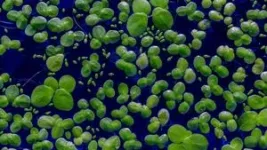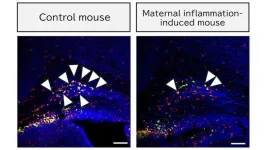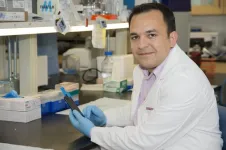(Press-News.org) Under the right conditions, duckweed essentially farms itself. Wastewater, ponds, puddles, swamps—you name it. If there’s enough sunlight and carbon dioxide, the aquatic plant can grow freely. But that’s not all that makes it intriguing. Packed inside duckweed’s tiny fronds is enormous potential as a soil enricher, a fuel source, protein-rich foods, and more. New findings at Cold Spring Harbor Laboratory (CSHL) could help bring all that potential to life.
CSHL Professor and HHMI Investigator Rob Martienssen and Computational Analyst Evan Ernst started working with duckweed over 15 years ago. They see their latest research as one of the most important and eye-opening studies on the plant to date. The team has developed new genome sequences for five duckweed species. The sequences reveal several genes that—when present or absent—may be behind the plant’s unique traits and versatility. Martienssen explains:
“The use of cutting-edge technology allowed us to make a catalog of genes that was extremely accurate. We could tell exactly which genes were there and which were not. A lot of genes that are missing are responsible for features of the plant—open stomata or the lack of roots. We could identify genes that were responsible for each trait.”
Stomata are pores on the surface of plants. They’re crucial for taking in carbon dioxide and releasing oxygen. Open stomata allow for greater intake, making them valuable for carbon capture technology. A lack of roots in some species further increases duckweed’s potential, making it easier for the plant to thrive in any watery environment.
Other species possess traits that showcase duckweed’s potential as a food and fuel source. Some traits promote high protein production, allowing for use as animal feed. Others promote starch accumulation, making the plant ripe for biofuel production. Several industries have taken notice. For now, they’re mostly concerned with the duckweed growing in their backyards. Ernst explains:
“Duckweed agriculture is in a nascent stage. Commercial growers are working with different species in the field, evaluating them in their own local situation. There’s so much variation within one species of duckweed—as much as you can find across all the species. So, having multiple genomes for multiple species is critical.”
Martienssen and Ernst hope their genomes will open the door to a new world of commercial applications. That said, their research may tell us as much about the plant’s past. Their study hints at how duckweed split off into different species 59 million years ago. Earth’s climate was quite extreme back then, so duckweed’s genes just might say something about the planet’s future, too.
END
The food and fuel that farms itself
2025-04-01
ELSE PRESS RELEASES FROM THIS DATE:
Patient- and Community-Level Characteristics Associated With RSV Vaccination
2025-04-01
About The Study: Knowledge of respiratory syncytial virus (RSV) disease and RSV vaccine eligibility was low in this cross-sectional study of hospitalized adults. Older adults and those with certain medical conditions were more likely to have received vaccine, suggesting appropriate prioritization, but sociodemographic differences in vaccine uptake occurred.
Corresponding Author: To contact the corresponding author, Diya Surie, MD, email dsurie@cdc.gov.
To access the embargoed study: Visit our For The Media website at this link https://media.jamanetwork.com/
(doi:10.1001/jamanetworkopen.2025.2841)
Editor’s ...
Intersectional Racial and Sex Disparities in Unintentional Overdose Mortality
2025-04-01
About The Study: In this cross-sectional study of overdose deaths, disparities in overdose mortality were evident, with Black men and Black women experiencing a pronounced and increasing burden of mortality compared with their white counterparts. Addressing these disparities will require a multipronged approach targeting the social, physical, economic, and policy risk environments.
Corresponding Author: To contact the corresponding author, Kechna Cadet, PhD, MPH, email kc3010@cumc.columbia.edu.
To access the embargoed study: Visit our For The Media website at this link https://media.jamanetwork.com/
(doi:10.1001/jamanetworkopen.2025.2728)
Editor’s ...
PLOS announces new partnership in China
2025-04-01
San Francisco, California, United States - The Public Library of Science (PLOS) and the Society of China University Journals (CUJS) today announced a 3-year strategic partnership between the organizations to work together on topics and content related to open access, open science, scientific integrity and scientific evaluation.
CUJS is an academic, national and non-profit social organization with more than 1,200 journal members. The organization conducts academic research and training programs in the editing and publishing of STM journals and promotes the development of STM ...
New options for controlling type 2 diabetes
2025-04-01
Nearly 40% of patients diagnosed with type 2 diabetes imperil their health by stopping their medication within the first year, UVA Health diabetes experts note in a new paper highlighting a growing array of treatment options.
The pragmatic new paper urges doctors to consider not just traditional diabetes medicines but emerging alternatives that patients may be more likely to stick with long-term. “Prescribing a medication or making lifestyle recommendations that a patient is not willing or able to follow for any reason is not likely to lead to improvements ...
Senolytics target Alzheimer’s-linked brain enzymes without harming healthy ones
2025-04-01
“This work provides new opportunities for the development of the next generation of ChE inhibitors that specifically target AChE and BChE associated with AD pathology.”
BUFFALO, NY — April 1, 2025 — A new research paper was published in Aging (Aging-US) on March 29, 2025, as the cover of Volume 17, Issue 3, titled “Differential senolytic inhibition of normal versus Aβ-associated cholinesterases: implications in aging and Alzheimer’s disease.”
In this study, a research team from Dalhousie University, led by Sultan Darvesh, discovered that certain anti-aging ...
An immune cell may explain how maternal inflammation causes neurodevelopmental disorder
2025-04-01
A research group led by Nagoya University Graduate School of Medicine in Japan has uncovered a potential mechanism linking maternal inflammation to delayed neurodevelopment in infants. The research suggests the role of CD11c-positive microglia—immune cells in the brain crucial for myelination—during infant brain development. The results, published in Communications Biology, suggest new strategies to mitigate the long-term neurodevelopmental effects of maternal inflammation.
Inflammation during pregnancy occurs when the mother’s immune system becomes activated during pregnancy, typically due to an infection, autoimmune response, or environmental factors. ...
New study refocuses research on mysterious falcon decline
2025-04-01
North America’s smallest falcon, the American Kestrel (Falco sparverius), has declined across the continent since the 1970s, yet the causes continue to stump raptor biologists. A new study published in the Journal of Raptor Research adds a piece to the puzzle with the discovery that in the Northeast, where declines are most alarming, fledglings demonstrate a relatively high survival rate. This paper, titled “Juvenile and Adult Survival Estimates of American Kestrels Throughout the Full Annual Cycle in Eastern North America,” is the first of its kind. No other study has assessed winter survival ...
Omega-6 fatty acid promotes the growth of an aggressive type of breast cancer
2025-04-01
Linoleic acid, an omega-6 fatty acid found in seed oils such as soybean and safflower oil, and animal products including pork and eggs, specifically enhances the growth of the hard-to-treat “triple negative” breast cancer subtype, according to a preclinical study led by Weill Cornell Medicine investigators. The discovery could lead to new dietary and pharmaceutical strategies against breast and other cancers.
In the study, published March 14 in Science, the researchers found that linoleic acid can activate a major growth pathway in tumor cells by binding to a protein called FABP5. Comparing breast cancer subtypes, the team observed that this growth pathway activation ...
FAU secures $1.3 million NIH grant for breakthrough in HIV self-test technology
2025-04-01
As of the end of 2023, nearly 40 million people worldwide were living with HIV, including approximately 1.2 million in the United States. In the same year, about 630,000 people globally died from AIDS-related illnesses. Although this is a significant decline from previous years, AIDS-related deaths remain a critical global health challenge.
While antiretroviral therapy (ART) has improved the life expectancy of people with AIDS, a lack of effective diagnostics and disease management tools has hindered its global implementation. Only 59% of those in need have access to treatment, and about one in four people living with HIV are unaware of their status. Additionally, ...
Study finds higher cardiac deaths in combined day-night heatwaves
2025-04-01
Cardiac deaths increase significantly during compound heatwaves—heatwaves where temperatures are elevated both during the day and overnight—according to a new study in JACC, the flagship journal of the American College of Cardiology. The study also found that some types of heart disease are more sensitive to heatwaves than others and that different types of heatwaves may impact heart health in distinct, nonlinear ways.
The research highlights the special risks of compound heatwaves ...






